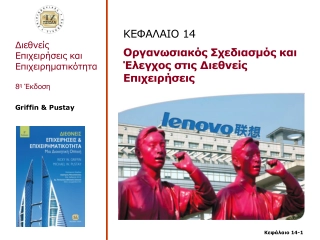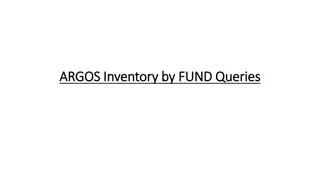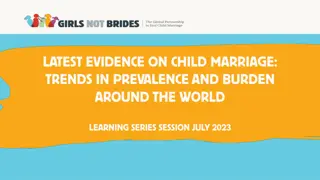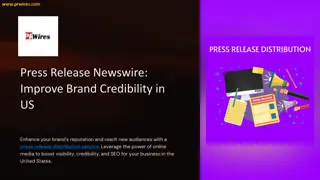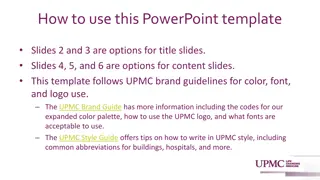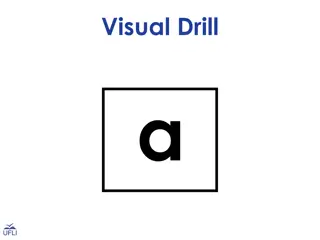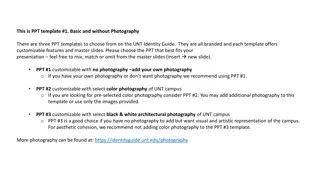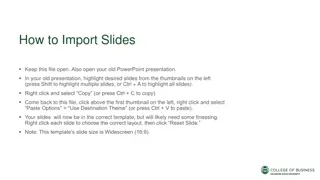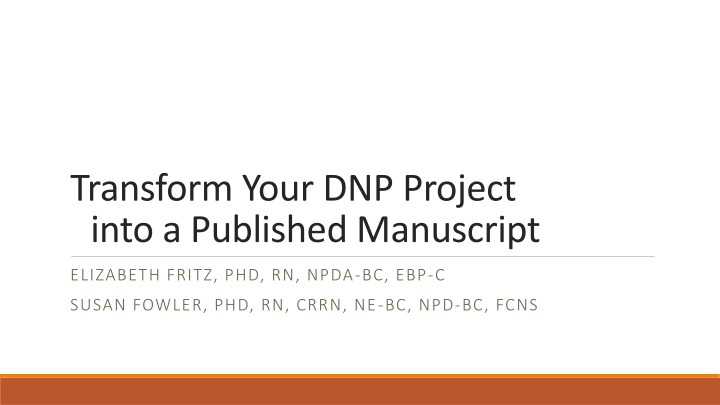
Transforming Your DNP Project into a Published Manuscript - Expert Guidance and Insight
Learn from Dr. Elizabeth Fritz and Dr. Susan Fowler about the process of transitioning your DNP project into a published manuscript. Understand reporting guidelines, challenges, and publication timelines. Gain valuable tips on streamlining content, utilizing tables and figures effectively, and replacing common capstone paper language with journal article standards. Enhance your evidence-based practice projects with insights on theoretical frameworks, implementation, evaluations, and implications for practice. Discover how to optimize your manuscript title and content for publication success.
Download Presentation

Please find below an Image/Link to download the presentation.
The content on the website is provided AS IS for your information and personal use only. It may not be sold, licensed, or shared on other websites without obtaining consent from the author. If you encounter any issues during the download, it is possible that the publisher has removed the file from their server.
You are allowed to download the files provided on this website for personal or commercial use, subject to the condition that they are used lawfully. All files are the property of their respective owners.
The content on the website is provided AS IS for your information and personal use only. It may not be sold, licensed, or shared on other websites without obtaining consent from the author.
E N D
Presentation Transcript
Transform Your DNP Project into a Published Manuscript ELIZABETH FRITZ, PHD, RN, NPDA-BC, EBP-C SUSAN FOWLER, PHD, RN, CRRN, NE-BC, NPD-BC, FCNS
Disclosures We are editors of AAACN publications.
Outcomes Learners will identify appropriate reporting guidelines for DNP capstone manuscripts. Learners will describe challenges in transitioning from school requirements to publication requirements for manuscripts. Learners will understand publication processes and timeline.
General recommendations CUT THE FLUFF USE TABLES & FIGURES APPROPRIATELY INCLUDE LESSONS LEARNED
Say this, not that COMMONLY FOUND IN CAPSTONE PAPERS PREFERRED IN JOURNAL ARTICLES Study or research used to describe a non-research project Initiative or project Broad terms understood by a wide audience Specific job titles or local jargon Significant not referring to statistical significance Important, key, meaningful, valuable
Using Reporting Guidelines Research QI STROBE (observational studies) EBP or EBQI SQUIRE
EQUATOR Network | Enhancing the QUAlity and Transparency Of Health Research (equator-network.org)
Evidence-based Practice Projects Theoretical Framework Implementation Evaluation of Outcome Implications for Practice Conclusion Worldviews on Evidence-based Nursing Introduction Organizational Assessment The Organization and its Structures The Issue and Opportunities Current State Clinical Inquiry PICO Question Review of the Literature Search Strategies Critical Appraisal Levels of Evidence Synthesis
Titles Examples It takes a village: Successful transition into practice for new graduate registered nurses Too long Does not reflect content Diabetes management: The power of nursed and health equity in quality improvement Unclear Re-write as needed
Introduction (of QI focused paper based on SQUIRE guidelines) Be clear WHY this problem is significant, especially to nursing Include both the problem and the local context Keep the context short and de-identified Local Problem Review of literature (available knowledge) Identify databases, key words, and years for the literature search Brief description of key articles A summary statement of the available knowledge captures support for the project Use most current relevant literature
SQUIRE Introduction continued Informal or formal frameworks, models, concepts, and/or theories used to explain the problem, any reasons or assumptions that were used to develop the intervention(s), and reasons why the intervention(s) was expected to work. Plan, Do, Study, Act LEAN Six Sigma - Yellow, Green, Black Belt ADKAR - Awareness, Desire, Knowledge, Ability and Reinforcement Theory (i.e., Watson s theory of care, Leininger theory of transcultural nursing Johns Hopkins EBP Model
SQUIRE Methods Context Site/setting People/roles Analysis Describe participant demographics (consider a table) Statistical analysis may be limited to descriptives Intervention This will vary based on the project Process or structure change, innovation, education Ethics Studies are considered non-human subjects research when they do not meet the 45 CFR 46 definitions of human subject research. Measures Describe data collection Describe reliability and validity of tools Using a nonhuman subjects determination request form, the Institutional Review Board deemed the project nonhuman subjects research. The Institutional Review Board deemed the project quality improvement, not research.
Common opportunities to shorten APPENDICES TABLES AND FIGURES SIDE BARS AI STATEMENT
Abstracts Often different from conference abstract Use a sample from the target journal Often written last Every journal has unique guidelines use them! Address the problem and purpose Describe the methods Keep text relevant to the audience of the journal Identify key results and implications
APA Pain Points Be consistent with terms and abbreviations throughout the manuscript. Do not capitalize every word in title of article. Every citation must have a reference. Citation software is not always correct. Remove reference formatting. Every URL must be functional. Include up to 20 authors (but check author guidelines). No retrieved from unless n.d. . Follow table formatting guidelines. Paraphrase preferred; use page number when quoting. Indent properly. Bold section headings and subheading. Do not put headings in italics; only 2nd level subheading. Use inclusive language.
The publication process what to expect Peer Review Decisions Back to peer review (repeat previous stage) Accept 1. Desk reject Revise and submit elsewhere 2. Send to peer review 1. Reject Revise manuscript and submit elsewhere 2. Accept (rare on first round) 3. Revise and resubmit (common) Revise and Resubmit Submit
References Appelbaum, M., Cooper, H., Kline, R.B., Mayo-Wilson, E., Nezu, A.M., & Rao, S.M. (2018). Journal article reporting standards for quantitative research in psychology: The APA Publications and Communications Board task force report. Am Psychol, 73(1), 3-25. https://doi.org/10.1037/amp0000191 Ogrinc, G., Davies, L., Goodman, D., Batalden, P., Davidoff, F., & Stevens, D. (2016). SQUIRE 2.0 (Standards for Quality Improvement Reporting Excellence): revised publication guidelines from a detailed consensus process. BMJ Quality & Safety, 25, 986-992. https://doi.org/10.1136/bmjqs-2015- 004411 Page, M.J., McKenzie, J.E., Bossuyt, P.M., Boutron, I., Hoffmann, T.C., Mulrow, C.D., Shamseer, L., Tetzlaff, J.M., Akl., E.A., Brennan, S.E., Chou, R., Glanville, J., Grimshaw, J.M., Hrobjartsson, A., Lalu, M.M., Li, Tianjing., Loder, E.W., Mayo-Wilson, E., McDonald, S., Moher, D. (2021). The PRISMA 2020 statement: An updated guideline for reporting systematic reviews. BMJ, 372. https://doi.org/10.1136/bmj.n71 Sebach, A.M., & Shellenbarger, T. (2020). Transforming DNP projects into publishable manuscripts. Nurse Author & Editor, 30, 1-8. https://doi.org/10.1111/j.1750-4910.2020.tb00057.x
Sue Fowler, PhD, RN, CRRN, NE-BC, NPD-BC, FCNS Editor, Journal of Ambulatory Care Nursing njfowlers761@msn.com Questions? Contact us! Elizabeth Fritz, PhD, RN, NPDA-BC, EBP-C Editor, ViewPoint elizabeth@nursefritz.com


